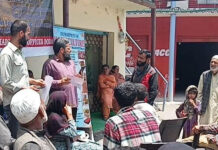The reopening of the Haldibari-Chilahati rail link is aimed at reducing the diplomatic distance between Delhi and Dhaka
Given the heaving presence of China in the region and its debt-trapping ways with our neighbours, it is important for India to strengthen bilateral relations and invest in mutually beneficial infrastructure than depend on a historicity of ties. While the Narendra Modi Government has been aggressively pursuing the “look East” policy, it has been aiming to make Bangladesh the arrowhead of its diplomacy. This has become all the more important considering that the Sheikh Hasina Government has been equally keen on Chinese investment and developing a transactional relationship with our eastern neighbour and counter-weighing that edge in its relationship with India. So New Delhi has been making efforts to further enhance transport and connectivity between India and Bangladesh and has revived the 55-year-old Haldibari-Chilahati rail link. The neighbours had earlier decided to resurrect the six pre-1965 rail links between the sides which the war had cut off. The other links that are set to be revived between West Bengal with Bangladesh are Petrapole (India)-Benapole (Bangladesh), Gede (India)-Darshana (Bangladesh), Singhabad (India)-Rohanpur (Bangladesh) and Radhikapur (India)-Birol (Bangladesh). Diplomatically, this eases the trade corridor with Bangladesh, boosting bilateral trade in the region. Strategically and politically, it eases India’s mainland connectivity to the Northeastern States, particularly Assam. The new rail link between Akhaura (Bangladesh) and Agartala, which is being funded by India, is likely to be operational by 2021 end. Both are the fastest growing economies in South Asia, and Bangladesh is expected to graduate from the LDC status to a developing country by 2024. The GDP per capita is also projected to rise there. The more India strides ahead in connectivity, the more it can keep Bangladesh as a buffer against China.
Why do we need Dhaka even more now? On the face of it, Bangladesh Prime Minister Sheikh Hasina assured India of respecting the organic nature of historic ties and soothed anxieties over the National Register of Citizens (NRC) exercise in Assam. But by foregrounding economic cooperation — one that spans connectivity, investment, power and infrastructure projects in her home country — she has also redefined the rules of bilateral engagement. The new reality has put us in a competitive slot vis-à-vis China, which has become one of the top trading partners of Bangladesh over the past couple of years. And in a multilateral world, where each nation is negotiating deals most beneficial to it and will not just pay obeisance to history, we can no longer afford to touch a raw nerve. There is a need to further woo Bangladesh, considering its deep discomfort over repeated statements from our Ministers on infiltration, minorities and the NRC. Particularly the idea that all “infiltrators” were “Bangladeshis”, repeatedly uttered in political speeches, has not gone down well among the people there. While many understand the difference between the political necessity of posturing and the diplomatic value, the overtly aggressive Hindutva messaging hasn’t quite sat easy with Bangladesh. So it is incumbent upon India to make Dhaka feel wanted at this juncture. Besides, Bangladesh is a key pillar in Prime Minister Narendra Modi’s neighbourhood diplomacy, what with it being a littoral nation and crucial to our role in the Indian Ocean. China has been quick to tap into the acute shortage of power in Bangladesh and has already taken up two mega power projects, hoping to enhance its presence in the energy market there. And while India is also a player in the power sector, it is difficult for Bangladesh to overlook China given its energy demands. For its part, India is working on joint projects on ports and roadways. If the Modi Government wants to make a success of its ‘Act East’ policy, we must invest meaningfully in our neighbouring nation.






























